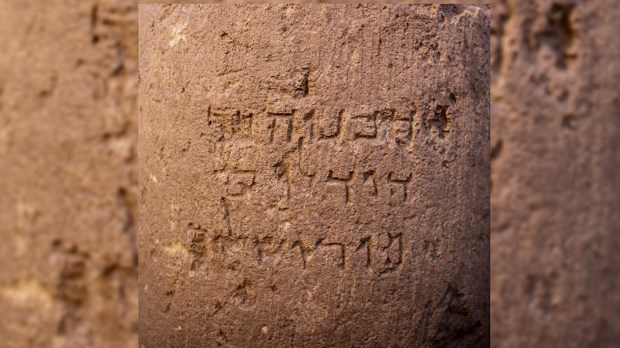Lenten Campaign 2025
This content is free of charge, as are all our articles.
Support us with a donation that is tax-deductible and enable us to continue to reach millions of readers.
A 2,000-year-old limestone column drum that went on display this week in the Israel Museum in Jerusalem bears an inscription with the words “Hanania son of Dudolos from Jerusalem” etched into it.
What makes it special is that the name of the city is spelled in Hebrew—Yerushalayim—much as it is spelled today.
Before this, the earliest known reference to the city with that spelling, outside of Scripture, was on a coin of the Great Revolt against the Romans (AD 66-70). The column drum predates that by several decades.
In the Bible, the name Jerusalem appears 660 times, and only five of those references, which are of a relatively late date, have the full spelling, according to the Israel Museum.
Discovered 10 months ago on an excavation site near the International Convention Center in Jerusalem, the column is about two-and-a-half feet high and has a diameter of one-and-a-half feet. It represents the first epigraphic testimony to the name Jerusalem spelled Yerushalayim (as it is written in Hebrew today), as opposed to Yerushalem or Shalem, the museum says on its website:
The column drum, discovered out of context, was originally part of a building that stood in a Jewish potters’ village on the outskirts of Jerusalem. The site was eventually converted by the Tenth Roman Legion into a workshop for ceramic building products. The column drum probably came from a workshop or some other structure belonging to Hanania or a public building that he helped finance. Hanania’s father’s name—Dudolos—is based on the name of the mythological Greek artist Daedalos; it may have been a nickname alluding to the father’s artistic abilities.”
The museum said that what is interesting about the etching is that although the village was very close to the city, “Hanania still found it meaningful to mention his Jerusalem origins.”
Prof. Ido Bruno, Director of the Israel Museum, stated: “As a resident of Jerusalem, I am extremely excited to read this inscription, written 2,000 years ago, especially when I think that this inscription will be accessible to every child that can read and uses the same script used two millennia ago.”
Dr. Yuval Baruch, Jerusalem Regional Archaeologist of the Israel Antiquities Authority, and Prof. Ronny Reich of Haifa University, who read and studied the inscription, said that First and Second Temple period inscriptions mentioning Jerusalem are rare.
“But even more unique is the complete spelling of the name as we know it today, which usually appears in the shorthand version. This is the only stone inscription of the Second Temple period known where the full spelling appears,” they said in a statement.
According to Dudy Mevorach, Senior Curator of Archaeology at the Israel Museum, “The archaeological context of the inscription does not allow us to determine where it was originally displayed, or who Hananiah son of Dodalos was. But it is likely that he was an artist-potter, the son of an artist-potter, who adopted a name from the Greek mythological realm, following Daedalus, the infamous artist.”
Mevorach told the Jerusalem Post that the reference to Daedulus “shows how the Jews of that time were influenced by Greek culture under Alexander the Great.”
“It is also unclear whether this was a dedication for a public building or if Hanania was showing his connection to his craft. These are questions that will help guide further excavations in this site,” the Post added.

